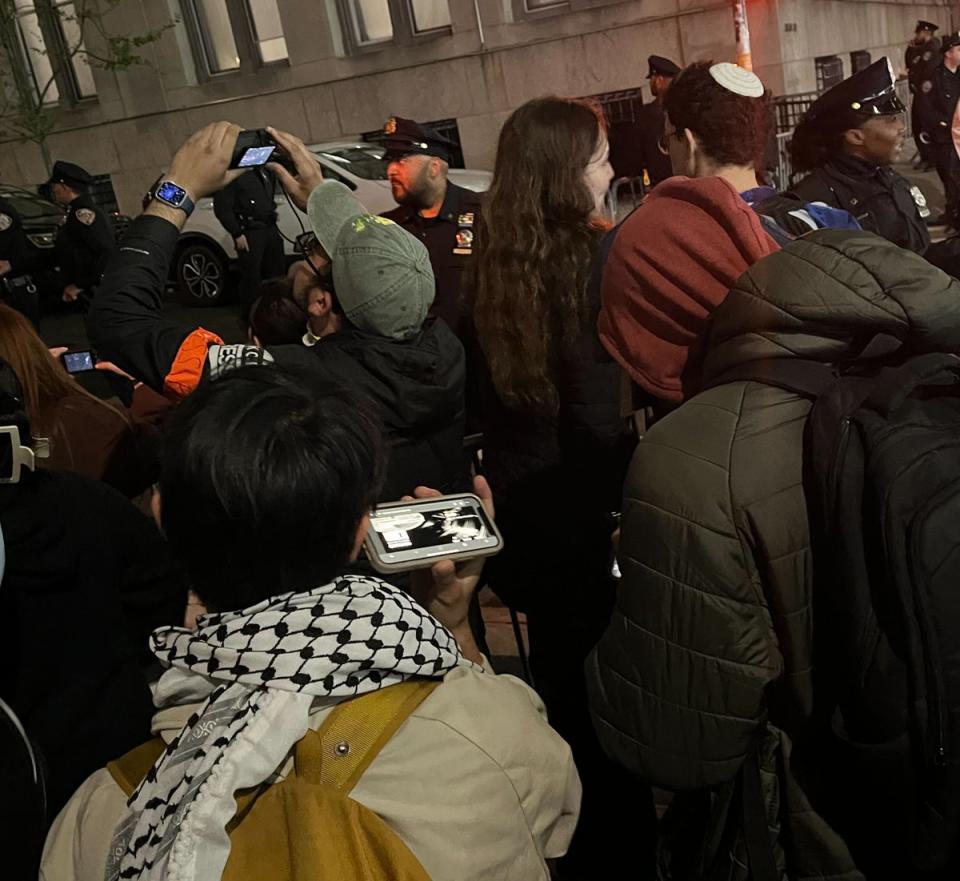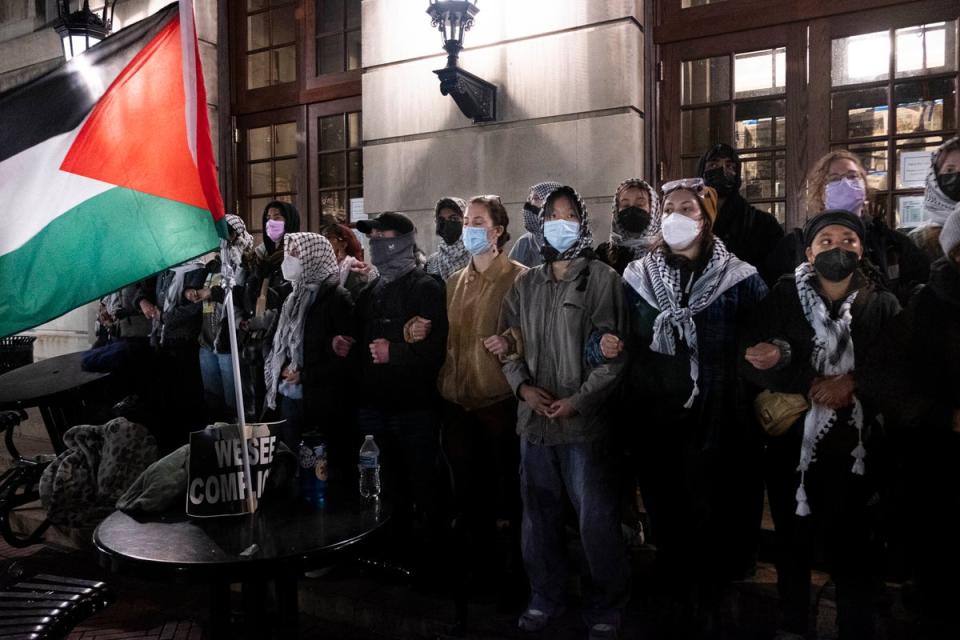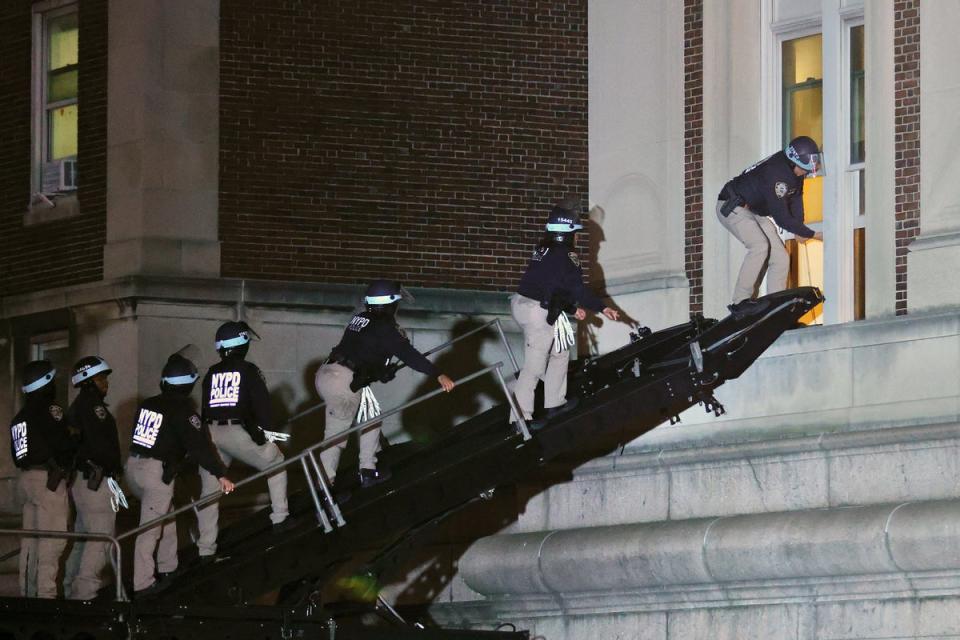Columbia student journalists broadcast NYPD college raid to the world from the inside
Banned from campus. Shoved to the street. Sleeping in classrooms. Trapped in a makeshift newsroom. Twenty-six hour days. Meeting deadlines for full-time jobs, and then for school publications. Going back to class. Repeat. Columbia University student journalists have found the biggest story of their lives right outside Pulitzer Hall.
Fifty six years to the day that New York City Police Department officers violently removed anti-Vietnam War protesters from Hamilton Hall, the world was watching as dozens of heavily armed and armoured NYPD riot police stormed Columbia’s campus to arrest more than 100 people on Tuesday night.
Members of the press — from local newspapers to national broadcasters — were blocked from campus, denying a full public accounting of the city’s militarized response to Gaza solidarity protesters and a disturbing show of force authorised by university administrators against their students.
Columbia’s student journalists, however, were there, on the ground, broadcasting to radio, photographing, shooting video, and writing it all down, just as they have been during their immersive coverage of student encampments that captured international attention.
“I have a full-time job. I have full-time school. I’ve been on campus every single day for the last few days. I haven’t slept,” Columbia Journalism School graduate student Fahima Degia told The Independent. “I was on campus the majority of the time, especially because when campus went on lockdown as we left, we could not come back.”
“We were like, ‘We need to capture this, we need to document this,’ and I think that was just really getting to the bread and butter of what journalism is,” said fellow Journalism school graduate student Shayeza Walid.
A late-night sweep from NYPD officers in riot gear, with sound cannon vehicles and busses intended for hundreds of arrested protesters, arrived roughly 24 hours after dozens of protesters occupied Hamilton Hall and barricaded the doors. Banners reading “Hind’s Hall” draped from windows of the occupied building, referencing Hind Rajab, a six-year-old Palestinian girl in Gaza killed by Israeli military.
And the only way to know what was going on was to listen to those on campus. Demand for live broadcasts from student-run radio WKCR FM crashed its website where student journalists delivered real-time, on-the-ground reporting, including questioning the institution’s claim that activists involved were “outsiders”. Protesters across campus and at other encampments across the country were tuned in.
Our team of 18 student volunteers is immensely proud to be providing this coverage to the Columbia community, NYC, and the world at large. We are incredibly appreciative of your support and understanding. pic.twitter.com/shq69vJotZ
— WKCR-FM NY (@WKCRFM) May 1, 2024
Reporters at The Columbia Daily Spectator, the university’s student newspaper, and student journalists sending dispatches to other outlets are giving readers the best up-close look at what’s happening on their campus.
“We are the ones on the ground. I know people that have slept there probably a week. People are exhausted, but they’re doing amazing work,” Columbia Journalism School student Emily Byrski told The Independent.
“I was very much running straight towards the cops last night and ready to get in the center of it,” she said. “It felt very, like, ‘OK, I’m exhausted. I’m pushing myself. I’m stressed and overwhelmed, but all of it’s worth it.’ It feels like a historic moment to be able to document.”

Reporters were correcting mainstream media and network news reports in real time while fielding requests for their own work and sources.
“A lot of us feel frustrated when we’re told by news companies or big media outlets like, ‘Hey, can you give me a source that you’ve been talking to and help me out?’” Degia told The Independent. “It’s so hard to build trust with sources in the encampment because a lot of them are scared for their safety and their identity being revealed because on school campus people are being doxxed.”
Columbia students established their latest protest encampment in mid-April to demand that the university divest from companies that help fund Israel’s war in Gaza, which has killed more than 34,000 Palestinians, most of them women and children. As Columbia students erected tents across the campus, and refused to be removed, the media flocked to interview them.
“I’m grateful for the student journalists who are doing more slow journalism, because they’ve had people during press hours just shove a camera in their face,” said Columbia Journalism School graudate student Angelica Ang, who wrote and photographed portraits of demonstrators for New York news outlet Hell Gate.
“And they felt that the narrative was being misconstrued in mainstream media. So I think to me, it was very important to get … unfiltered voices of what they actually were trying to achieve,” she said.
“I think we get frustrated and we feel taken advantage of in a way because media companies just message us for our sources that we’ve been trying to build instead of helping support our work and give us opportunities to get published,” Degia said.

Student journalists were thrust into a chaotic dynamic to report on their classmates, about their university’s decision to send in the police, from a centre sharing a namesake with the Pulitzer Prize, with coverage that could very well earn them one.
A host on WKCR appeared to acknowledge that situation on Tuesday night, telling listeners that Columbia “supposedly cares enough about journalism to have a journalism program” while the police the university allowed on campus threatened students with arrest if they left the Journalism school.
Hours before hundreds of officers entered campus, students received a warning about “heightened activity” with a command to “shelter in place.”
Student journalists’ phones were blowing up with updates in group chats and with messages from their professors.
That “heightened activity” message “doesn’t really mean anything. But obviously all of us knew that NYPD were coming,” Walid said. “We were getting pictures of NYPD cars lining up on Amsterdam [Avenue], 30-40 cars … We knew that they were gonna come in and at that point, we were just preparing to cover it.”
It’s nearly midnight & the @columbiajourn newsroom is buzzing. pic.twitter.com/WLjE0ObJoZ
— Sheila Coronel (@SheilaCoronel) May 1, 2024
The campus was closed off. Deans and professors had to convince police to let their journalism students into their buildings.
“And that is just very surreal to me, because the only way that we’re going to get these stories right is if we’re there,” Byrski told The Independent.
“Professors made sure we had signs all over us. The cops knew who we were. They didn’t let us past a certain point after they started entering campus. They pushed everyone back,” she said.
Student journalists “were just trying to take pictures, videos, audio, just trying to document what’s going on, and they were prohibited,” Degia said.
“Pushed and pushed and pushed – they just kept pushing us and making sure of that and following us until we would leave the premises,” she told The Independent.
One of her classmates was knocked to the ground while photographing an arrest.
“They were like, ‘Get off the street, get off the street, get off the street!’ and then the protesters who were getting arrested were like, ‘She’s just press!’” she said. “He was kind of getting aggressive with her, so I went to go comfort her and hug her … She’s just doing her job.”
Police used force, protestors say. The latest debrief on @Columbia from @dreamgirlfahima @columbiajourn https://t.co/3bApGWjULa
— Uptown Radio (@UptownRadio) May 1, 2024
A surge of 200 officers entered campus, a “comical” amount compared to what was left of the encampment and the small group inside Hamilton Hall, Walid said.
“Obviously only the ones who were in front of Hamilton making the human picket line or inside were the ones who were going to get arrested,” she said. “The tents were empty. … When the police came in … they were just like, you know, kicking the tents. They found nothing. And we captured that on photo and we were writing that down and I was reporting it.”

Inside Pulitzer Hall, where the Brown Institute for Media Innovation was turned into a makeshift newsroom, reporters were “kind of awestruck,” she said.
“I’ve never seen so much police in my life … And also the police didn’t even know what to do because there was so many of them. It was clearly a disproportionate amount that came in that even they were kind of just standing there,” Walid said.
In a statement to students, Columbia Journalism School dean Jelani Cobb applauded students who had been out reporting: “We believe that journalists have a fundamental right to cover the news. Your efforts turned those sentiments into reality. You told the stories the global public deserved to hear. You helped the School to meet its mission.”
One professor told a student journalist for the Spectator that their reporting will serve as a final paper: “You’re earning an A. Just take care of yourself and your friends.”
By the time the encampment was cleared, and the rain had stopped, “there was this weird realization that there’s not gonna be any remnants or archives of what was here, and the only things we have are any of the photographs that were taken, or any of the things we’ve written up,” Walid said. “And that was really disheartening to think about.”
“It just makes me more passionate about covering things that matter, making sure that I’m the first person on the scene to get the real facts and details about what’s going on,” Degia told The Independent. “And making sure the voices that aren’t heard and seen are heard and seen.”

